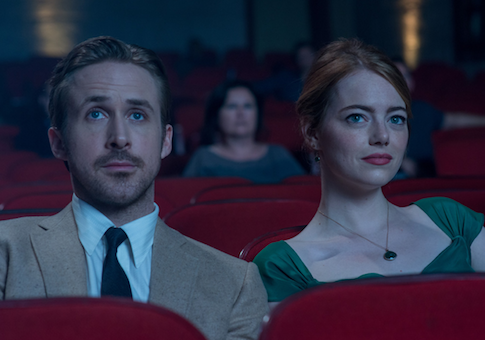Plot points for the whole of La La Land, including the ending, are discussed below.
I've noted before that I don't much care for musicals. I'm not a stickler for reality in my filmmaking, exactly; it's just that the particular stylization of musicals has always left me feeling somewhere between "cold" and "actively annoyed." With the exception of cartoons, I can count the number of musicals I actually enjoy on one … finger.*
I'm usually happy to admit that this is a personal flaw and move on. Fortunately for me, there are very few song-and-dance filled films that are required viewing; only a couple a decade, generally speaking. So it was with some trepidation that I saw the mounting awards-season buzz for La La Land: a lighthearted, life-affirming musical, rife with riffs, packed with jams, praised to the heavens. The Rotten Tomatoes score skyrocketed. Critics who had seen it on the festival circuit floated into D.C.-area screenings, practically giddy, singing its praises.
Rarely had I been more ready to hate a movie.
And for the first hour or so of La La Land, all of the things that have always annoyed me about musicals were present. My smug certainty that La La Land would be no different from all the rest of its brethren remained firmly in place.
We open on a Los Angeles freeway, traffic at a standstill, a title card informing us that the bright sunny day and the rolled down windows and the 20-somethings in t-shirts are actually enjoying Winter. Bored dreamers are trapped in their cars—until they aren't, until they're singing and dancing, until they're praising Hollywood and going on about how they're just going to make it if they try, until director Damien Chazelle's camera is whip-panning around to create the illusion that this was all done in a single take.
The toe-tapping artifice sets the stage, as does the middle finger that Sebastian (Ryan Gosling) flips Mia (Emma Stone) as he speeds around her on the freeway. She's on her way to work as a barista on the lot at Warners, where she's making lattes while waiting for her big break. He's on his way to his bachelor pad, where he's waiting for the perfect gig that will allow him to open a jazz bar where the music's done the right (read: old) way.
Their paths cross again in a restaurant, where she hears him playing a soulful tune and wants to say how much it meant to her before he blows by her, exiting in a huff, fired by a boss who wanted Christmas standards. And they cross again when she sees him some weeks later at a party, where he's playing keys for a terrible '80s cover band. It isn't until that party ends that they finally get a chance to dance—and that's kind of a problem. Because Stone and Gosling are really quite charming when they're chatting—when they're flirting and ribbing each other. Once the curtain of artifice falls and they're doing a number in front of a rear-projection Los Angeles sunset, all the magic between them promptly disappears. They're just … actors.
Everything above goes double for the dance amongst the stars a bit later on set at the Griffith Observatory. Never has so much schmaltz left me feeling so cold.
As the film progresses, however, the song-and-dance numbers become fewer and more organic. The two grow closer then further apart. We see Sebastian at work with a sell-out neo-jazz band that he hates but plays with because it pays the rent and puts a nice roof over the couple's head. Mia belts out a tune at an audition about an aunt who lived in Paris—the spotlight thrown on her by the film makes sense, as she's told to just go ahead and talk, to wow the casting director.
Mia's only at the audition because Sebastian tracked her down in Nevada, her home state, to which she has fled because the one-woman show she had been planning was a disaster—a disaster unseen by Sebastian, who was stuck at work. And Mia nails that audition, earning a ticket to Paris. But she can't bring Sebastian. Fade out.
When we next see them together, it's five years later. She's married (not to him) and has a child (not with him). She's a star, her face in lights and on posters. Mia and her man head out for a date, stopping by a new jazz club, taking a seat by the stage. It's "Seb's," and Sebastian sits behind the piano, playing their theme—and suddenly, we spin into a new song and dance, this one set in the past, replaying their relationship and the film as a whole in miniature.
Perhaps it's from her POV, perhaps his; either way, everything's a little different. Their first meeting isn't a brush-off but an embrace, and he's there for her throughout. It's a what-might-have-been fantasy that only really works because of the whimsical way in which it's shot—which itself only works because of the musical numbers that have studded the film. As we come to the close of the number, which somewhat cruelly reminds us that there are no do-overs in life, I could feel my anxieties about La La Land's genre melt away.
Perhaps it's simply because the artifice added so greatly to the art, or maybe I've grown mawkish in my dotage. But, whatever the reason and much to my surprise, I quite enjoyed La La Land. And I imagine most moviegoers will too.
*For the record, the list is, in its entirety, Willy Wonka and the Chocolate Factory and also maybe Enchanted, which only really half-counts, since it's basically just a cartoon brought to "life."
